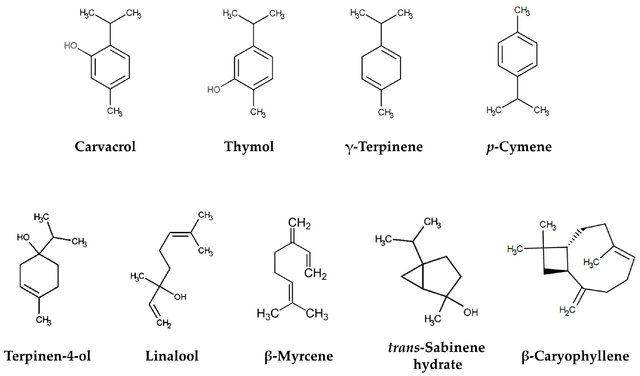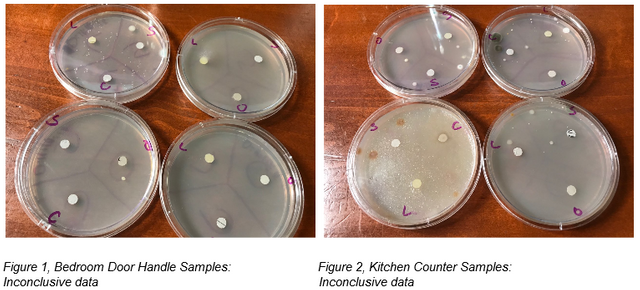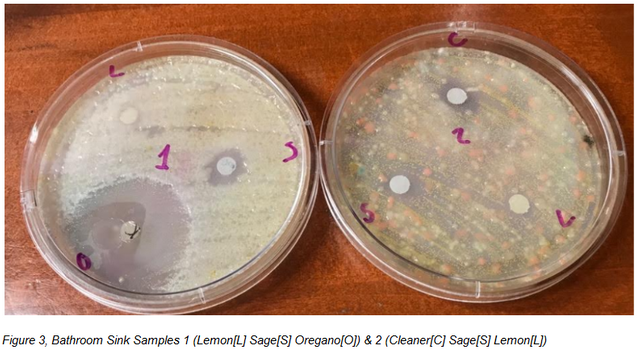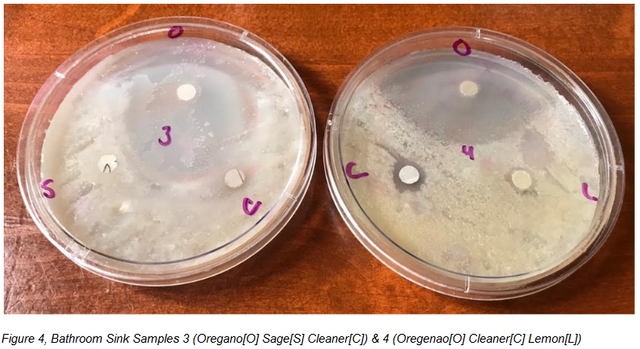The Antifungal Efficacy of Salvia officinalis (sage), Origanum vulgare (oregano), and Citrus limon (lemon) essential oils [Experiment and Research Paper]
The following research paper is the completed experiment I organized and proposed for my General Chemistry 223 class this term. We were directed to create a project backed by an activity to present to the class via a poster board, and a paper for the instructor. The only limitations we were given was that the project had to be chemistry based. So, without question, I chose biochemistry/microbiology. This research paper was one of the most difficult that I've had to write as my teacher required that what ever our activity was that we had to directly relate it to chemistry. Sounds easy enough. Or so I thought - there is very little research done on the mechanism of action of the antibiotic activity of essential oils, in turn making it extremely difficult to dig up the chemistry behind the mechanism. I spent days pouring over research papers, and it wasn't until I began following references through rabbit holes that I finally breached the chemistry behind the veil. I hope you enjoy this following paper as much as I enjoyed writing it, I certainly learned a great deal about one of my passions through this journey. I look forward to your comments and questions!
Abstract
The purpose of this experiment was to test three different commonly available essential oils for their antifungal properties against a standardized household cleaner. These three variables were Salvia officinalis (sage), Origanum vulgare (oregano), and Citrus limon (lemon) essential oils, while the control was 409 All-Surface Cleaner, with the main cleaning agent dimethyl benzyl ammonium chloride. Four microbial samples were applied to sterile Malt Extract Agar petri dishes using the bacterial lawn streak method from three environments. Each of the petri dishes was visually divided evenly and a variable or control was applied to each section in such a way that each compound could be compared. The samples were evaluated using the Kirby-Bauer disk diffusion method to measure and compare the diameter of each Zone of Inhibition after incubating in the dark at an average of 26°C for five days. Each of the compounds showed at least a mild antifungal activity, with oregano oil displaying the greatest efficacy.
Introduction
Toxicity
The importance of knowing the toxicity of the compounds we use regularly in our daily lives is key to maintaining our health. Synthetic household cleaners often have high toxicity levels and relatively low lethal dose medians (LD50), the value of the dose which kills 50% of the test subjects when administered in a single exposure (OSHA 2012), while many widely available naturally occurring phytocompounds have low toxicity levels and relatively high LD50. For example, the LD50 of bleach fumes in rats was measured to be 850 mg/kg (UC 2004), while the LD50 of Salvia officinalis (sage) in rats was measured to be 4,000 mg/kg (Eidi 2006). Even pure eugenol, a known toxic compound found in small parts of the essential oil of clove, only has a LD50 of 1,980 mg/kg in rats (Sober 1950).
Environmental Impact
The chemicals that are produced, and used to synthesize many common household cleaners, are not only toxic to humans and animals but they easily contaminate the environment causing disruption of natural cycles. Sodium Dodecyl Sulfate (SDS) is one of the most common anionic surfactants used in households and industrially. SDS is released in large amounts into the water systems after its use (Chaturvedi 2011). According to the Centers for Disease Control and Prevention, “[SDS] is toxic to aquatic organisms. It is strongly advised that this substance does not enter the environment (2008).” Meng-Hsin Lee et al showed in their research that dimethyl benzyl ammonium chloride, the control used in this study, targets the ribosomal structures of sulfate-reducing bacteria, an anaerobic microbe which helps cycle sulfur containing compounds (2010). In contrast, essential oils are typically extracted with plain water through the application of steam distillation. Essential oils are also volatile aromatic compounds which breakdown readily with time and/or heat, making them relatively safe for environmental use (Opender 2008).
Mechanism of Action
Essential oils are mainly composed of a combination of several different mono- and sesquiterpenes and aromatic polypropanoids (Simon 1997). The antibiotic properties of hundreds of essential oils is well documented; however, the mechanism of action is not quite as well researched. The antibiotic properties of essential oils has been correlated to the presence of phenolic compounds and their hydrophobicity (Lucchini 1990). Jan Sikkema et al revealed in their study, Mechanisms of Membrane Toxicity of Hydrocarbons, that lipophilic compounds such as the hydrocarbons of essential oils, are partitioned into the cell membrane by the phospholipid bilayer surrounding the cell wall due to the existing concentration gradient (1995). The accumulation of these compounds in the cell wall disrupts the proton motive force, and the interaction of essential cell functions such as membrane embedded protein channels and enzymes (1995). A. Ben Arfa, et al, showed in their study that the presence of the hydroxyl group of the phenolic compounds acts as a proton exchanger thus diminishing the proton motive force through reducing the gradient across the cytoplasmic membrane (2006). The accumulation of the phenols in the cell wall allows the hydroxyl group to hydrogen bond with cellular functions which disrupts cellular integrity, leading to the depletion of the ATP pool, eventually causing cell death (2006).
Concluding Thoughts
Common synthetic household cleaners are toxic to our health and often fatal if consumed. Many phytocompounds have low toxicity levels and are relatively safe for consumption. Synthetic contaminants readily toxify the environment they are released into, while phytocompounds are relatively neutral in their impact on the environment. Thus, it is important to research the antimicrobial efficacy of common essential oils in order to discover potential replacements for harmful synthetic cleaners. The essential oils containing the most phenolic compounds will show an antibiotic efficacy that is greater than that of the control.
Methods and Materials
Four sets of three different environments were sampled for microbes: four from the kitchen counter, four from the bathroom sink, and four from the bedroom door handle. Samples were taken using sterile cotton swabs and applied to sterile malt extract agar (MEA) growing medium in petri dishes using the bacterial lawn streak method to ensure even inoculation. MEA is an acidified growing medium which inhibits the growth of bacteria, allowing for molds and yeasts to proliferate. Each of the petri dishes was divided visually into three sections and labeled as one of the three variables, or the control, in such a way that each could be compared. A sterile round piece of paper soaked in one of the three variable oils or the control was placed in the center of each of the three divided sections. The petri dishes were left to incubate in a warm (Average 26°C), dark place for five days. The Kirby-Bauer disk diffusion method (KBDD) was used to determine the antifungal efficacy of each of the different compounds through the measurement of the presence, or absence, and diameter of a Zone of Inhibition (ZOI).
Results
Only one set of data out of the three different environments was viable, as the microbial samples from the bedroom door handle and the kitchen counter did not effectively proliferate which created inconclusive data (see figures 1 & 2). However, each of the essential oils displayed varying degrees of inhibition in the measured data set (see figures 3 & 4).
The averages of the diameter of the ZOI for each of the tested compounds were as follows: Lemon oil, .15cm; Sage oil, .25cm, Oregano oil, 2.3cm. Each of these was compared to the control: dimethyl benzyl ammonium chloride, .41cm (see Table 1).
Discussion
As predicted, Oregano showed the greatest antifungal efficacy when compared to the control, dimethyl benzyl ammonium chloride, while each compound displayed some variance of antifungal activity. These results are concurrent with other findings, such as those of Danesh, et al, in that carvacrol and thymol act as powerful fungicides, with these being the two main chemical constituents of oregano oil (2017). Carvacrol and Thymol are both phenolic compounds which, as was discussed previously, are shown to act as powerful antibiotics through their hydrogen bonding and proton exchange through their hydroxyl group.
Neither sage oil nor lemon oil contain any phenolic compounds; however, they do contain compounds with hydroxyl groups, such as linalool, which may be correlated with the mild fungicidal activities of each. Further research upon the concentration levels of compounds absent of phenols required to act as a stronger fungicide may be of some benefit.
It is also interesting to note that in data set 3 from the bathroom sink, the oregano oil inhibited a large radius, but after some time a mold grew inward from the edge of the ZOI towards the oil disk. Without taking a biological assay of the microbe, it is impossible to say for certain what is actually happening; however, an research has shown that carvacrol and thymol have an affinity towards beneficial microbes (Du 2015). While at the same time there a study was done on the bacterial resistance development of E. coli with limonene which showed that the pathogen was able to rather quickly mutate and develop a resistance to the compound (Espina 2013).
There are a few things that might be occurring with these studies in mind. The mold that is growing inward may be a mold that shares some sort of affinity with oregano oil, thus taking higher concentrations to act as a fungicide. Another hypothesis is that it is one of the molds that was wiped out by the oregano oil, but then mutated to develop a resistance towards the fungicide. Perhaps neither of these was occurring and that the concentration of the oregano was too dilute and evaporated, as volatile compounds quickly do, which then allowed for the mold to proliferate.
Pharmaceutical antibiotics are useful in extreme and severe cases of bacterial infections, but they show no affinity for those microbes which are necessary for a healthy microbiome. This experiment, and many others, have shown that oregano oil is a powerful antibiotic, while also showing an affinity towards probiotics. With the level of efficacy as an antibiotic well documented for this oil, and knowing that it takes higher concentrations to eliminate beneficial microbes, a new area of development would be to test the affinity for the beneficial microbes of the human microbiome in vivo.
Literature Cited
Arfa, A. Ben, et al. “Antimicrobial Activity of Carvacrol Related to Its Chemical Structure.” Letters
in Applied Microbiology, vol. 43, no. 2, 2006, pp. 149–154., doi:10.1111/j.1472-765x.2006.01938.x.
CDC. SODIUM LAURYL SULFATE - International Chemical Safety Cards - NIOSH. The
National Institute for Occupational Safety and Health (NIOSH), Apr. 2008, www.cdc.gov/niosh/ipcsneng/neng0502.html. Accessed 7OCT18.
Chaturvedi, Venkatesh, and Ashok Kumar. “Diversity of Culturable Sodium Dodecyl Sulfate (SDS) Degrading Bacteria Isolated from Detergent Contaminated Ponds Situated in Varanasi City, India.” International Biodeterioration & Biodegradation, vol. 65, no. 7, 2011, pp. 961–971., doi:10.1016/j.ibiod.2011.07.005. Accessed 7OCT18.
Danesh, Rezaee. Damir, S. Najafi, S. “Study on Antifungal Effects of Several Essential oils Against Botrytis cinerea and Rhizopus stolonifer.” Oxidation Communications. 2017, Vol. 40 Issue I-I, p195-208. 14p.
Du, Encun, et al. “In Vitro Antibacterial Activity of Thymol and Carvacrol and Their Effects on Broiler Chickens Challenged with Clostridium Perfringens.” Journal of Animal Science and Biotechnology, vol. 6, no. 1, 2015, doi:10.1186/s40104-015-0055-7.
Eidi M, Eidi A, Bahar M. “Effects of Salvia officinalis L. (sage) leaves on memory retention and its interaction with the cholinergic system in rats.” Nutrition . 2006;22(3):321-326. Accessed 7OCT18.
Espina, Laura, et al. “Mechanism of Bacterial Inactivation by ( )-Limonene and Its Potential Use in Food Preservation Combined Processes.” PLoS ONE, vol. 8, no. 2, Dec. 2013, doi:10.1371/journal.pone.0056769.
Lee, Meng-Hsin Phoebe, et al. “Effects of Biocides on Gene Expression in the Sulfate-Reducing Bacterium Desulfovibrio Vulgaris Hildenborough.” Applied Microbiology and Biotechnology, vol. 87, no. 3, Feb. 2010, pp. 1109–1118.,
doi:10.1007/s00253-010-2596-1.
Lucchini, J.j, et al. “Antibacterial Activity of Phenolic Compounds and Aromatic Alcohols.” Research in Microbiology, vol. 141, no. 4, 1990, pp. 499–510., doi:10.1016/0923-2508(90)90075-2.
Opender Koul, Suresh Walia, and G.S. Dhaliwa. Essential Oils as Green Pesticides: Potential and Constraints, Biopesticides International, vol. 4, no. 1, 2008, pp. 63-84. Date Accessed 7OCT18.
OSHA. Hazard Communication Standard: Safety Data Sheets. Occupational Safety and Health Administration, U.S. Department of Labor, 2012, www.osha.gov/Publications/OSHA3514.html Accessed 7OCT18.
Sikkema, Jan. De Bont, Jan A.M.. Poolman, Bert. “Mechanism of Membrane Toxicity of Hydrocarbons.” Microbiological Reviews, American Society of Microbiology, June 1995, p. 201-222. doi: 0146-0749/95/$04.0010
Simon, James E. “Essential Oils and Culinary Herbs*.” Advances in New Crops, Purdue, 1997, hort.purdue.edu/newcrop/proceedings1990/V1-472.html.
Sober A. Herbert, Hollander Franklin, Sober K. Eva. Eugenol Toxicity, Experimental Biology and Medicine, vol. 73, issue 1, 1950. doi: 10.3181/00379727-73-17608. Accessed 7OCT18.
UC Regents. Lethal Dose Table. Living by Chemistry, Regents of the University of California, 2004, http://whs.rocklinusd.org/documents/Science/Lethal_Dose_Table.pdf. Accessed 7OCT18.
Join us in The Philoso-Forum to discuss philosophy and the occult arts with like-minded individuals!
LOVELAUGHTER&&XHAOS
High Priest, Loser of Found Souls, Temple of Appled Thought
Erisian Ataxia Troupe : Caste of the Black Sun






I am a big fan of oregano oil and have used it successfully in the past for a tooth infection, it is very strong and very potent. I must say I am very impressed and excited to see actual visual evidence of it's efficacy, great job.
I recently read about a medical student in the U.K that studied the antibacterial properties of breast milk and I done a post about it too, but seeing how the milk actually ate away at the bacteria in the petri dishes was very cool, she also tested it on e.coli and mrsa with the same results. Here's a link if you are interested
https://www.mnn.com/family/babies-pregnancy/stories/petri-dish-experiment-shows-amazing-powers-breast-milk
That’s really awesome that you were able to successfully heal a tooth infection using oregano oil. Tooth infections are really severe difficult to get rid of! I’m glad my experiment gave validity to your experience!
I was completely unaware of the antibiotic activity of breastmilk!! That is very interesting. I’ll have to look more into the research myself, but do you know off the top of your head if it showed any sort of affinity to probiotics? It seems kind of counterintuitive to be giving a newborn antibiotics when our micro biome is so important. Quite intriguing regardless.
Amazed by your work, and stoked we have someone like you to test stuff out for us! Buying oregano oil now for sure!
Thank you kindly. It’s great to be able to persue my passion:)
Excellent post !! I am working with my students on a project of cultivation and properties of the oregano, the children learned how to prepare medicinal oregano oil at home!
Super awesome! Do you mind sharing what method you taught to prepare the oil?
Of course friend, first you must dry the leaves of oregano in the sun, after two days in the sun, well dry, grind with your hands, add a vegetable bowl, olive oil, maize or any other edible oil. your preference and let warm, you incorporate the dried oregano with the help of a teaspoon to move the oregano to release its properties, and then without letting it fry, remove and store in a clean container, leave at least two weeks the oregano oil protected in a cool place, to use only you must toamr and ready, THE OREGANO OIL IS GOOD TO DESTROY THE FLEMA, FOR THE INFLAMMATED FLU AND AMIGDALAS.
Cool! Do we know on what can oregano oil be paired with to sustain or maintain its' efficacy? Can those oils be mixed?
Sage oil has shown synergistic effects with other oils lowering their minimum concentration levels for inhibition of growth of microbes, perhaps that might be one to look into. All the oils can be mixed, but whether or not they have synergistic effects is another question.
Sounds interesting! You'll gonna do that? You seem so busy..that would be cool!
To listen to the audio version of this article click on the play image.

Brought to you by @tts. If you find it useful please consider upvoting this reply.
Very cool! Great to see some conclusive facts around essential oils! That oregano oil!! ⭐️
Thank you! I love being able to see the activity of these essential oils in vitro. It’s an amazing experience to behold.
This post has been voted on by the SteemSTEM curation team and voting trail in collaboration with @utopian-io and @curie.
If you appreciate the work we are doing then consider voting all three projects for witness by selecting stem.witness, utopian-io and curie!
For additional information please join us on the SteemSTEM discord and to get to know the rest of the community!
This is really fascinating, I really appreciate how much work went into this study. Thank you so much for sharing you work!
The efficacy of natural compounds truly is fascinating! I’m glad that you enjoyed this work :-) let me know if you see anything that could be improved upon!
Nice. Let us know how you go with it once it’s marked.
I’m not here to market things, I’m here to inform people to be able to take their medicine into their own hands when possible. :-)
No, I meant tell us how you go with the paper... after it’s graded, etc. 🤣😉
Posted using Partiko iOS
That is a really thorough experiment. Very cool.
Thank you, I’m glad you enjoyed my work! Is there anything that you see that could be improved upon?
If I ran the experiment I would do color coding for the various elements. It helps my brain process data better.
It is really cool because I had read online how amazing oregano oil was and seeing it in action is amazing.